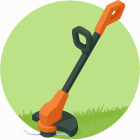The Ultimate Guide to Weed Eaters
If your yard game is anything but pristine, a weed eater (aka weed wacker, string trimmer, or grass trimmer) is the single tool that will rescue edges, tame flower beds, and make your lawn look intentional. This guide walks you through how to choose one, how to use it well, and what maintenance keeps it humming season after season.

What type should you pick?
First, decide the power source. Gas weed eaters still win for raw power and long runtimes, great when you have acres or really stubborn brush. For most homeowners, a battery powered weed eater or electric weed eater is smarter: quieter, lighter, and lower maintenance. Brands that regularly pop up in reviews include Stihl, Echo, Husqvarna for gas, and DeWalt, Milwaukee, Ryobi, Worx, Black and Decker for battery or corded models. If you already own tools from a brand, choosing a battery operated weed eater on the same platform can save you money on batteries.
Shaft style matters too. A straight shaft is more rigid and better for taller people or heavy duty work; a curved shaft is lighter and nimble for small yards and edging.
Key features to check
- Cutting system: bump feed heads are cheap and simple; fixed line or automatic heads reduce hassle.
- Line diameter: thicker line (0.095-0.155 inch) cuts heavier grass and weeds.
- Motor type: brushless motors on battery models mean more torque and longer life.
- Weight and balance: try to lift before you buy; a heavy trimmer will wear you out fast.
- Attachments: some models convert to an edger, hedge trimmer, or brush cutter , handy if you want one platform for many tasks.
How to use a weed eater like a pro
Stand with a relaxed grip, keep the head parallel to the ground, and move in a controlled sweeping motion. For edging, rotate the head vertically and sweep along the walkway for crisp lines. Don’t jam the head into thick stems; slow, repeated passes are kinder to the motor and line. Wear eye protection, long pants, and sturdy shoes; gas models also require hearing protection.
Quick tip: For consistent edges, use the top of a curb or a string line as your guide. Sweep away from yourself and keep the trimmer head just above the ground to avoid rocks and root scars.
Maintenance checklist
- Replace worn weed eater string before it snaps constantly.
- For gas units: clean air filter, replace spark plug yearly, and use fresh fuel (stabilizer helps).
- For battery units: store batteries cool and charged at about 40 to 60 percent if not used for months.
- Inspect the guard and shaft for damage; a bent shaft reduces efficiency.
Buying advice and recommendations
If you need heavy duty work, look at Stihl string trimmer, Echo, or Husqvarna for longevity and dealer service. For cordless convenience, DeWalt, Milwaukee, and Ryobi offer powerful battery powered weed eaters with different battery ecosystems. Budget shoppers find value in Black and Decker or Craftsman; those who want high end cordless performance should compare DeWalt and Milwaukee brushless models. Home Depot and Lowe’s carry wide selections if you prefer trying weight and balance in person.
Final thought
A great weed eater removes the drudgery from yard work and raises curb appeal overnight. Match the machine to the yard: battery for tidy suburban lawns, gas for heavy brush, and prioritize comfort and line compatibility. With the right trimmer and a little practice, edging becomes almost enjoyable.

